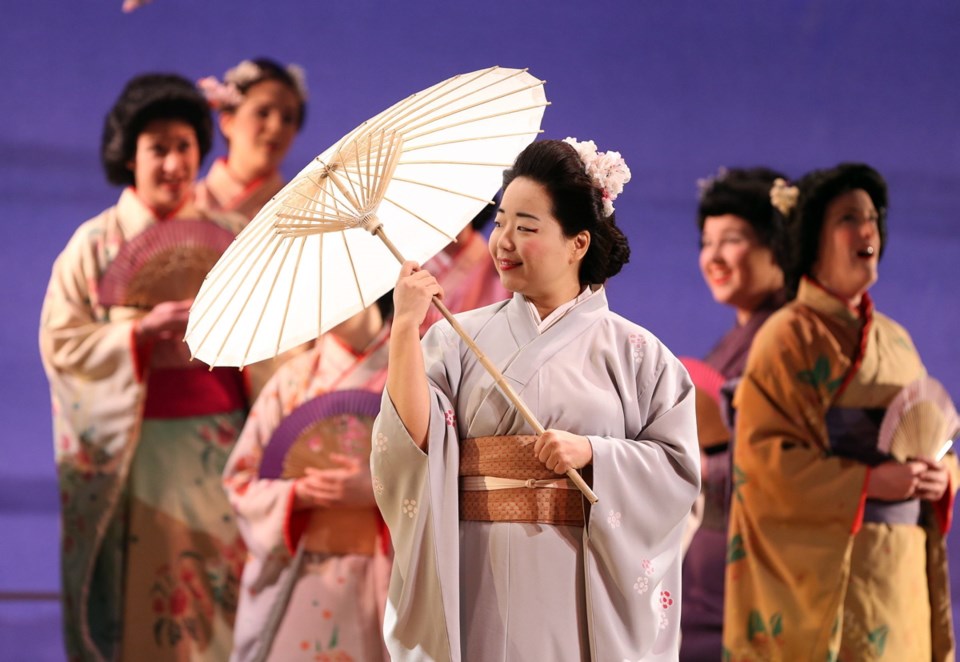What: Madama Butterfly
Where: Royal Theatre
When: Tonight, April 15, 17, 19
Rating: 4 1/2 (out of five)
If art and passion alchemize in exactly the right way, it can provide soul-stirring moments of transcendence.
When this happens, it’s marvellous, reminding even the most jaded theatre-goer why we make the effort.
Such is the case with Pacific Opera Victoria’s new production of Madama Butterfly. The company has already enjoyed considerable artistic success this season with worthwhile stagings of Das Rheingold and Lucia di Lammermoor. Yet nothing topped the thrills offered by Madama Butterfly on opening night, particularly those provided by the young singer in the title role.
Korean soprano Jee Hye Han is making her North American debut as Cio-Cio San (Butterfly). On Thursday, the audience leapt to its feet when Han appeared at curtain call, reserving for her its most enthusiastic applause. And no wonder — she’s a terrific performer with the kind of big, creamy voice that works so well for Puccini. What’s more, Han was able to fully convey Butterfly’s strange, passive tragedy.
The story is a Westerner’s fantasy: a docile Asian girl loves an American cad, no matter what. Societal attitudes regarding women and race have shifted since this opera debuted in 1904 and this creates a problem for contemporary stagings of Madama Butterfly. The challenge is to make today’s theatre-goer forget social politics by seducing us with the opera’s pathos and beauty.
Pacific Opera Victoria has more or less managed this. It’s a traditional adaptation, with a stage-wide recreation of a Japanese home and a full-size cherry-blossom tree. The costumes are well-cut and tasteful, particularly the pastel-coloured kimonos. Diana Leblanc’s direction reveals the story in a detailed and thoughtful way, even though it doesn’t overcome the static quality of Butterfly’s seemingly never-ending overnight vigil.
The Victoria Symphony played vigorously under Giuseppe Pietraroia’s baton, although the volume occasionally drowned out the singing.
The aria everyone anticipates is one of opera’s most famous. Butterfly rhapsodically imagines Pinkerton’s return after three years with Un bel di, a poetic fantasy that describes the wisp of smoke that will plume as his white ship enters the harbour.
The heartbreaking way Han delivered Un bel di captured the opera’s contrasting elements: Butterfly’s tremendous love and loyalty to Pinkerton . . . and also the fact her affections are doomed. Here and elsewhere, the soprano seemed perfectly suited, displaying a seamless legato line, her notes rounded and velvety. Blessed with a naturally beautiful voice, Han exhibited superior command of technique. She’s one of those singers who makes it sound effortless and she projected well, her buttery voice displaying thrilling heft in dramatic passages.
A handsome young singer, tenor Adam Luther seemed sensibly cast as Pinkerton, although he didn’t quite match the high-octane thrills provided by his co-lead. Among his best moments was the extended love duet with Butterfly, Viene la sera, which saw them affectionately caressing each other’s faces. And Luther convincingly conveyed Pinkerton’s deep remorse near the end of the opera.
Some of the evening’s most fervent applause went to the mezzo-soprano Armine Kassabian. Singing Butterfly’s maid, Suzuki, Kassabian is not only a strong singer but a superior actress. Her reactions to Butterfly’s betrayal (she learns of it before her mistress does) provide a powerful framework for the story, giving it even greater magnitude.
The care with which Leblanc directed this opera is manifested in many ways: the elegant simplicity of the movement; the fleeting dance-like sequences; and the formality with which Butterfly’s robes were removed on the wedding night, conveying her vulnerability and misplaced trust as much as anything.
The heroine’s famous night-long wait for Pinkerton boasted stunning visual flourishes (Alan Brodie oversaw the lighting, Patrick Clark did the set and costumes). That said, I wasn’t sure about a silhouetted tableaux during this scene, which seems stilted.
Overall, Madama Butterfly works well. Despite its naturalistic look, the production came across as a gorgeous antique fantasy, an intoxicating dream that — buoyed by the beauty of Puccini’s melodies — engages all our senses.
